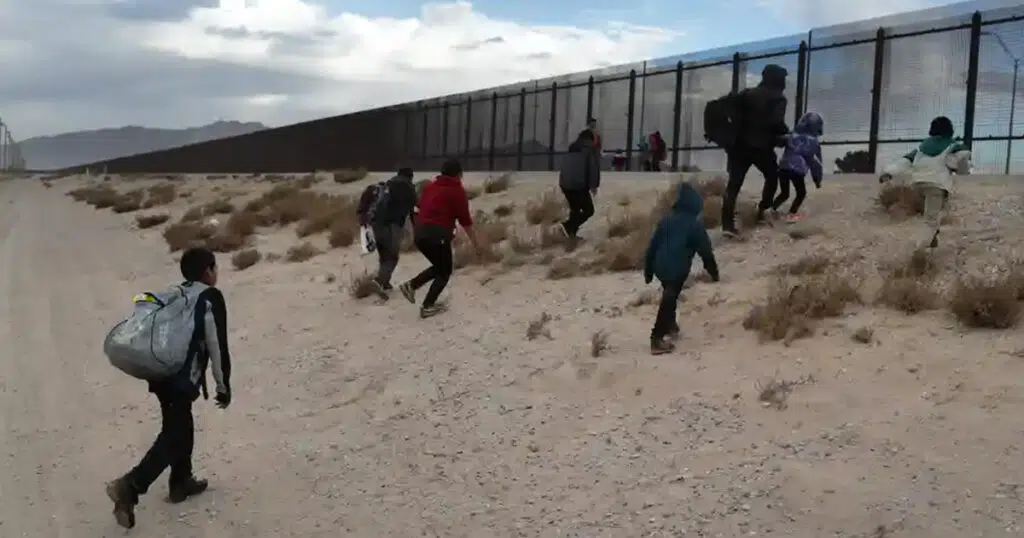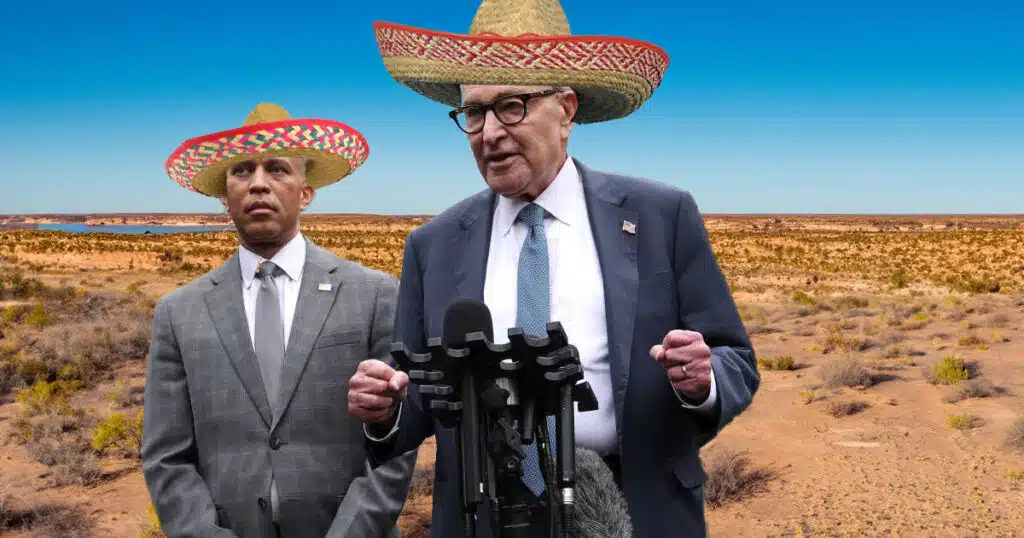
The Invasion Equation
The Army National Guard vs. The Invading Cartel Armies
Rape trees, river floaters, skeletal remains, and fentanyl candy. The new vernacular of illegal immigration is an indictment of the U.S. Department of Homeland Security’s (DHS) loss of operational control along the U.S.-Southern border. A consequence of this is the transformation of cartel insurgencies into well-formed armies that recruit and employ uniformed soldiers, have supporting intelligence operations, and control terrain. The challenge now confronting state and federal law enforcement is no longer how to deter an insurgency; it’s how to defeat an army.
Modern armies are resourced by nation-states who provide moral leadership in times of war. But the accountable governments of nation-states can falter and fail. Mexico in particular has a compromised central government that is not protecting its own homeland from subversive actors. When this happens, a conglomerate of paid professionals, mercenaries, conscripts, and criminals fills the void to either protect or exploit the resources of a community. It was true within the first communities of Mesopotamia, and it is happening now in communities across Mexico. This is how armies begin. A state is incapable of securing its communities, accountable governments lose legitimacy, and subversive actors start vying for control of terrain to exploit resources.
The hallmark of any effective army is its ability to control terrain. The cartel armies have done that by co-opting the gangs of the U.S. and operate the world’s largest crime syndicate complete with narco distribution hubs throughout the U.S.. In Mexico they cordon cities and run roadblocks to collect information and extort residents. To date, as much as 20 percent of Mexico has come under control of the cartels as previously reported by CIA analysts. Their center of gravity is the illicit drug and human trafficking revenues from which they derive their strength. The illegal aliens that they infiltrate, the drugs that they smuggle, and the terrorist that they give safe passage each infiltrate the Southern border under their control and further empower their control of terrain.
The Invasion Word
Armies deter aggression and win the nation’s wars by dominating the land. So, the maxim goes… But this is a description that prescribes to a classical definition of state-on-state aggression initiated by an invasion of one state’s sponsored military against another’s. Article 4, Section 4 of the U.S. Constitution even guarantees that the U.S. shall protect its states against invasion. And if not, Article 1, Section 10 permits states the right to protect themselves from an invasion. These “invasion clauses” are the genesis of the debate that is occurring between the federal government and border states. The federal government clings to the classic definition of an invasion and does not believe the humanitarian disaster occurring under the control of cartel armies constitutes an invasion. Whereas border state Governors believe in a 21st century asymmetric style of invasion pointing to the infiltration of bad actors causing economic and criminal harm to their states. Regardless, the federal dogma continues along the line that an invasion is an “armed hostility from another political entity.”
To date, America’s next great leader has yet to emerge and articulate a coherent unified response to the 21st century cartel invasion. Instead, a range of state-based strategies and stunts have been developed. Governor Gregg Abbott of Texas has passed an executive order empowering his state to apprehend illegal immigrants in certain circumstances as well as designating Mexican cartels as terrorist organizations, Arizona Governor Doug Ducey was seeking court affirmation for his state’s right to defend itself, and Florida Governor Ron DeSantis is focusing on trafficking operations. And each of the aforementioned Governors has since adopted the political stunt of giving illegal aliens safe passage to sanctuary cities in northern states via bussing. As a result, cartel armies continue to consolidate power and gain control of territories while states bear the brunt of economic and criminal impacts.
Deploying the National Guard
The loss of operational control along the U.S.-Southern border by DHS has forced border state Governors into a constitutional dilemma. To date, no Governor has challenged the federal government to enforce federal immigration law and turn back persons seeking illegal entry. Instead, states such as Texas are relying on their own state constitutional authority to use the National Guard to arrest illegal aliens committing crimes. In fact, the National Guard has had a continuous presence on the Southern border since 2014 when former Texas Governor Perry deployed 1,000 troops to interdict Cartel del Golfo (Gulf Cartel). Deploying the National Guard to interdict cartel armies remains a desirable option due to the federal government’s abandonment of the border. But when opting for this option the Governor’s and their military commanders must maintain strategic symmetry throughout all facets of the operation. On-going challenges the National Guard is confronting on the border has generated the following principles that should be addressed when conducting border operations.
- A Task Force is not a Strategy
- Don’t Surge Your Troops to Failure
- You Can’t Go to War with a Border
- Build Consensus Between the Diplomats, the Bureaucrats, and the Generals
A Task Force is Not a Strategy
Governors love a good Task Force. And they exist for virtually every political, economic, and social purpose. As far as the border is concerned, Current task forces include Arizona’s Task Force Badge to support local law enforcement in border towns; New Mexico’s Human Trafficking Task Force; and Texas’ Task Force on Border and Homeland Security. These task forces sometimes strain due to the broad scope of concerns they attempt to address. Governor’s fall into a ‘my task force is bigger than yours” mentality and end up creating over representative committees. For instance, Texas’ Task Force on Border and Homeland Security has representatives from eight state agencies, the Border Sheriffs’ Coalition, county judges, mayors, property rights organizations, concerned citizens, and border community prosecutors. Good luck with that task force developing a specific focus.
A bloated think-tank style “task force” creates ambiguity at the operational level that lacks strategic context. What often results are large task forces that try to cover all conceivable scenarios due to the absence of a unified strategy. Inevitably, the Governor responds to think-tank style task forces and their recommendations and begins to implement what is confused as a strategy. Whereas the General tries to facilitate force structure and build a strategy within their joint staff. Thus, the two begin to react to separate problem sets.
Don’t Surge Your Troops to Failure
The National Guard is an operational force that provides strategic depth to our nation’s Army and Air Force. Over the past two decades the National Guard became quite adept as a resource provider to the Middle Eastern wars. In this federal role the National Guard followed a deliberate mobilization process lasting up to a year that culminated with properly trained, equipped, and missioned Soldiers. State led missions on the other hand are led by the Governor and TAG who controls the state’s National Guard. These National Guard soldiers and airmen are activated on state active duty and remain under the command and control of the Governor while costs are incurred by the taxpayers of the state. In this capacity the state’s TAG is responsible for training, readiness, and oversight of soldiers and airmen.
Governors don’t understand this concept and instead believe that the military exists within a perpetual state of readiness. And because of this belief they are quick to surge troops to the border when political pressure builds. Doing this wrong had disastrous results in Texas. Just this past summer a “no notice surge” of up to 10,000 troops to the Texas-Mexico border was attempted by the Governor. What resulted was a logistical nightmare of delayed pay, substandard living conditions, and equipment shortages. Most egregious were a number of suicides attributed to forced mobilizations because of no warning, and a tragic drowning due to limited training. In the wake of this disaster the TAG, Major General Tracy Norris, was replaced due to her inability to plan an operation, other senior officers were reassigned, and the number of troops on the border was reduced.
You Can’t Go to War with a Border
The Prussian Soldier and writer Carl von Clausewitz wrote over two hundred years ago that war is not exerted on inanimate or passive human material. The U.S.-Mexico border is an inanimate terrain feature. It does not think or fight. The thinkers and fighters are “Cartel Americana” that have saturated the Americas in depth throughout the northern and Southern hemispheres. Defeating the illicit activities of the cartel armies requires a defense in depth strategy extending to within the cities and towns of the U.S. away from the border. What is required is a higher order of operational strategy consisting of what military theorist Liddell Hart refers to as the “concentration of strengths against weaknesses”.
The strength of the National Guard is its array of specialized units and human capital that do not exist within the active component of the U.S. military. Units such as homeland response forces, counter drug programs, cyber defense teams, and information operations; amongst other specialized capabilities could be the focus beyond the border. The primary intent should be to reclaim the physical and digital terrain that the cartel armies have seized. Augmenting the special agents within the Criminal Investigation Divisions of each state’s County Sheriff’s Offices, Attorney General’s Office, and Departments of Public Safety would provide a real threat to the cartel army’s self-preservation. Physical interdictions do not cease but instead become enhanced on the border.
Build Consensus Between the Diplomats, the Bureaucrats, and the Generals
A Governor that decides to deploy the National Guard takes on the role of a diplomat to convince both the citizenry and state legislature for the need of civil self-protection. The messaging that the Governor delivers must be persuasive enough to receive popular support, pass legislation, and forge a budget. In Arizona Governor Doug Ducey influenced state legislators to create a border security fund consisting of $55 million; Florida Governor Ron DeSantis created a consortium of state law enforcement agencies expending $1.6 million to provide border security support to Texas; and Texas Governor Greg Abbott influenced his state legislature to provide $3 billion to finance the Operation Lone Star mission. Building consensus for a budget proposal is a core competency of Governorship. However, building funding consensus is not synonymous with strategic consensus.
Governors, as the Commander in Chief of state military forces, are responsible for providing a strategic context to their National Guard troops. They should be able to rely on their existing agencies to craft that strategic context. The strategic aptitudes of a state exist within the Department of Emergency Management, Department of Public Safety, and Military Department (National Guard) who possess competent strategic planners. It is within these departments and agencies that a strategic framework is developed to visualize the operation in time, space, and purpose. From that, operations at the tactical level are developed, and resources applied through existing state bureaucracies. Doing this right requires strategic patience which is antithetical to a Governor who may have just negotiated a “border package” and needs a surge to commence. Thus consensus on a strategy often is strained from the very first press conference.
Conclusion
Current border state Governors have been forced into a situation non dissimilar to Reagan’s dilemma of 1984 when he responded to the Soviet Union’s influence in our hemisphere. During that time Reagan stated, “the United States has a legal right and a moral duty to help resist the subversive activities of the Soviet Union.” The dilemma of our hemisphere today is how to defend the United States from cartel armies. It’s not good practice to commit large military formations to long term criminal enforcement. It’s simply not within the DNA of America’s founding principles. However, the U.S. is being invaded by cartel armies as they continue to infiltrate the U.S.. How our Governors decide to leverage Constitutional authorities will determine if this war can be won.
Colonel Clarence Henderson (U.S. Army, ret.) is a former Infantry Brigade Combat Team Commander and U.S. Army War College graduate with over 20 years of active service and multiple worldwide deployments. He was the former commander of all troops on the border under Governors Rick Perry and Greg Abbott of Texas.
This article was originally published by RealClearDefense and made available via RealClearWire.



